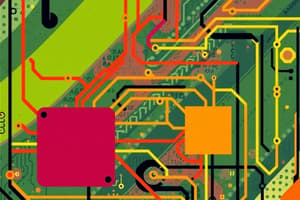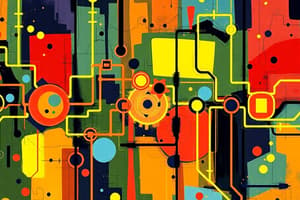Podcast
Questions and Answers
What is electricity?
What is electricity?
Electricity is the flow of electric current, which is a flow of electric charge, usually in the form of electrons, through a conductor such as a wire, a metal, or a semiconductor.
What is a series circuit?
What is a series circuit?
A series circuit is a type of electrical circuit where all components of the circuit are connected in a single path.
What is the formula to calculate the total resistance of a series circuit?
What is the formula to calculate the total resistance of a series circuit?
1/R_total = 1/R_1 + 1/R_2 + 1/R_3 + ...
What are the advantages of a series circuit?
What are the advantages of a series circuit?
How is voltage distributed in a series circuit?
How is voltage distributed in a series circuit?
What is the formula for electric power?
What is the formula for electric power?
What is the efficiency of a device?
What is the efficiency of a device?
What are some basic safety tips for working with electricity?
What are some basic safety tips for working with electricity?
What are the disadvantages of series circuits?
What are the disadvantages of series circuits?
How can electric power be harnessed?
How can electric power be harnessed?
Flashcards are hidden until you start studying
Study Notes
Electricity and Circuit
Electricity is the flow of electric current, which is a flow of electric charge, usually in the form of electrons, through a conductor such as a wire, a metal, or a semiconductor. It is a physical phenomenon that plays a crucial role in our daily lives, powering a wide range of devices and systems. In this article, we will discuss the concepts of electricity and circuit, with a focus on series circuits, electric power, and electric safety.
Series Circuits
A series circuit is a type of electrical circuit where all components of the circuit are connected in a single path. In other words, each component is connected to the power source and to the next component in the circuit. Series circuits are simple to set up and can be used to power a single device, as all the power is passed through the device.
In a series circuit, the voltage is distributed evenly among the components, but the current is highest at the power source and lowest at the load. This is because the resistance of the load causes a drop in voltage, which in turn causes a decrease in the current.
The total resistance of a series circuit can be calculated using the formula: 1/R_total = 1/R_1 + 1/R_2 + 1/R_3 + ..., where R_total is the total resistance and R_1, R_2, R_3, ... are the resistances of the individual components.
A series circuit has several advantages. It is simple to set up and can be used to power a single device. It also allows for easy addition of components, as each new component can be added in series with the existing components.
However, series circuits also have some disadvantages. The voltage drop across the load can cause the device to not work properly, as it may not receive enough power. Additionally, if one component in the circuit fails, it can cause the entire circuit to stop working.
Electric Power
Electric power is the rate at which electrical energy is transferred by an electric circuit. It is measured in watts (W) and is equal to the voltage (V) multiplied by the current (I). The formula for electric power is: P = V x I.
Electric power can be transferred through a wide range of devices, including light bulbs, motors, and appliances. When a device is powered, it converts the electrical energy into another form of energy, such as light, heat, or mechanical motion.
The efficiency of a device is the ratio of the output power to the input power. An efficient device will convert a high percentage of the input power into useful output power, while an inefficient device will lose a large amount of the input power as heat.
Electric power can be harnessed from a variety of sources, including fossil fuels, nuclear reactions, and renewable sources such as solar, wind, and hydroelectric power.
Electric Safety
Electric safety is an important consideration when working with electricity. Electricity can be dangerous and can cause injury or even death if proper precautions are not taken. Some basic safety tips for working with electricity include:
- Turn off the power before working with any electrical device.
- Use insulated tools to prevent accidental contact with live wires.
- Never touch a live wire or electrical outlet.
- Avoid working with electricity in wet or damp conditions.
- Use surge protectors to protect devices from power surges.
- Follow the manufacturer's instructions when working with any electrical device.
By following these safety tips and taking other appropriate precautions, you can minimize the risk of injury or damage when working with electricity.
Conclusion
In conclusion, electricity and circuits play a crucial role in our daily lives, powering a wide range of devices and systems. By understanding the concepts of series circuits, electric power, and electric safety, we can use electricity safely and efficiently. Whether you are working with a single device or a complex electrical system, it is important to take the necessary precautions and follow best practices to ensure the safe and effective use of electricity.
Studying That Suits You
Use AI to generate personalized quizzes and flashcards to suit your learning preferences.




